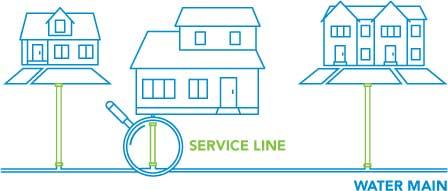How can I find out if I have a water service line or household plumbing that contains lead?
Visit the inventory map on the front page of denverwater.org/Lead. Denver Water has information on the sources of lead in drinking water, as well as its Lead Reduction Program that will protect our customers and future generations from the risk of lead in drinking water.
Is there a way for homeowners to tell by visual inspection if their service line is lead or not? Can I look and see if it is copper into or out of the meter and would that tell me anything?
- Identifying the material of a service line can be challenging, as plumbing codes vary and different pipe material and fittings were used during different decades. The materials available today were not necessarily available decades ago.
- While a visual inspection of the service line where it connects to your water meter can provide some insight, it doesn’t indicate what other materials may be used in other sections of the service line buried underground. We have found that service lines can be made of more than one type of material. Denver Water may still need to conduct investigations to confirm that no sections of your service line contain lead.
What if I don't think my service line has lead?
- As part of Denver Water’s regulatory requirements for the Lead Reduction Program, we must be able to show that either Denver Water has replaced the lead service line or have proof that there is no lead in the home. Because water service lines are customer-owned, Denver Water doesn’t know with certainty what the material of the service line is after the tap on the main in the street and into the property. The Lead Reduction Program is focused on making sure a customer’s entire service line is free of lead. If work was performed on a property’s service line in the past, it is possible that the work only removed part of an existing lead service line. Another section that may contain lead could still be carrying water into the home.
- Denver Water needs to complete the investigation process to remove a property from the Lead Reduction Program. We complete investigations to gather additional information and data so that we are confident in removing your property from the program. Once we have completed our investigation process and can confirm if should be included in the program, we will send you a letter of the results.
- If you replaced the service line on your own and have documentation, invoices or paperwork that shows those details, send to Denver Water at lead@denverwater.org to review these records to verify whether there was a full service line replacement from the main to the house.
If the water main was replaced in front of my property, do we still have lead concerns?
The Lead Reduction Program is focused on identifying and replacing customer-owned lead service lines. The service line brings water into your home from the water main in the street. A water main replacement does not guarantee that your service line is not made of lead. To determine whether or not you have a lead service line, Denver Water will need to conduct an investigation using a combination of property and assessor records, water tap dates, water quality tests and/or visual inspections of the service line.
What do I need to look for when buying new plumbing fixtures or faucets?
Replace pre-2014 faucets with new “lead-free” options. Fixtures installed before 2014 are likely to contain some brass, even if they have a chrome finish. View the Environmental Protection Agency’s fact sheet on how to identify lead-free certification marks for drinking water system and plumbing products at epa.gov/nscep.

